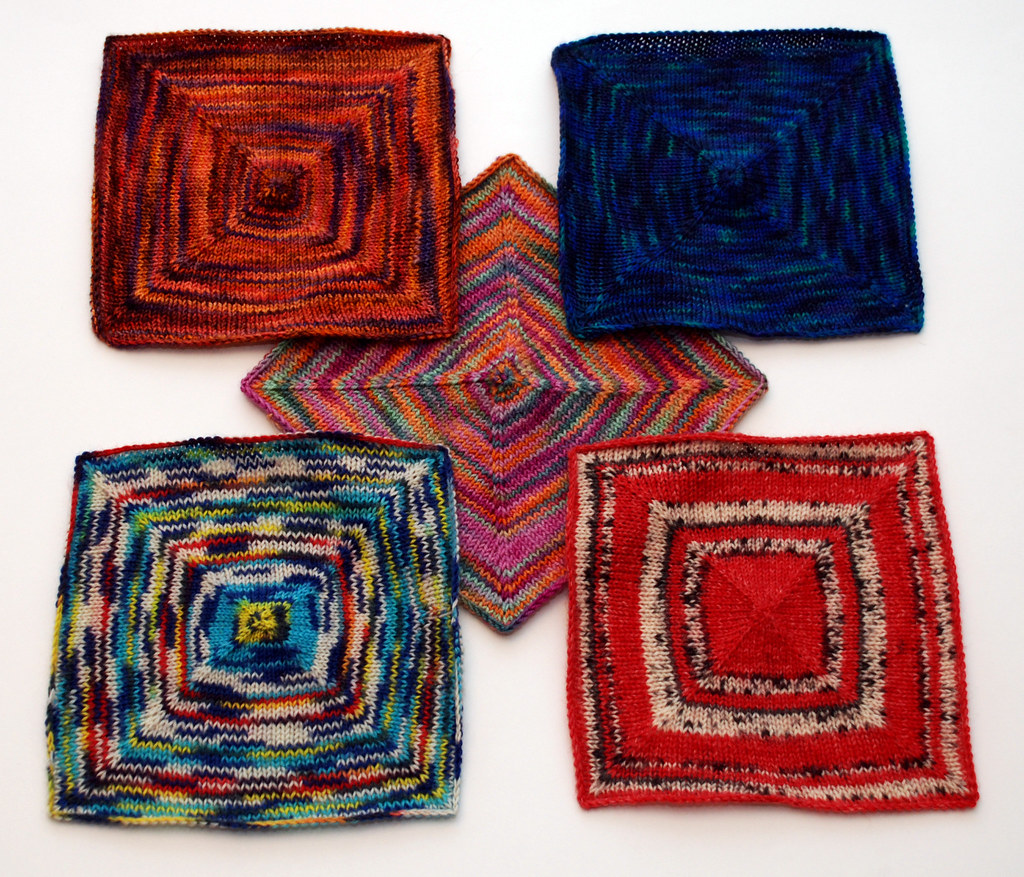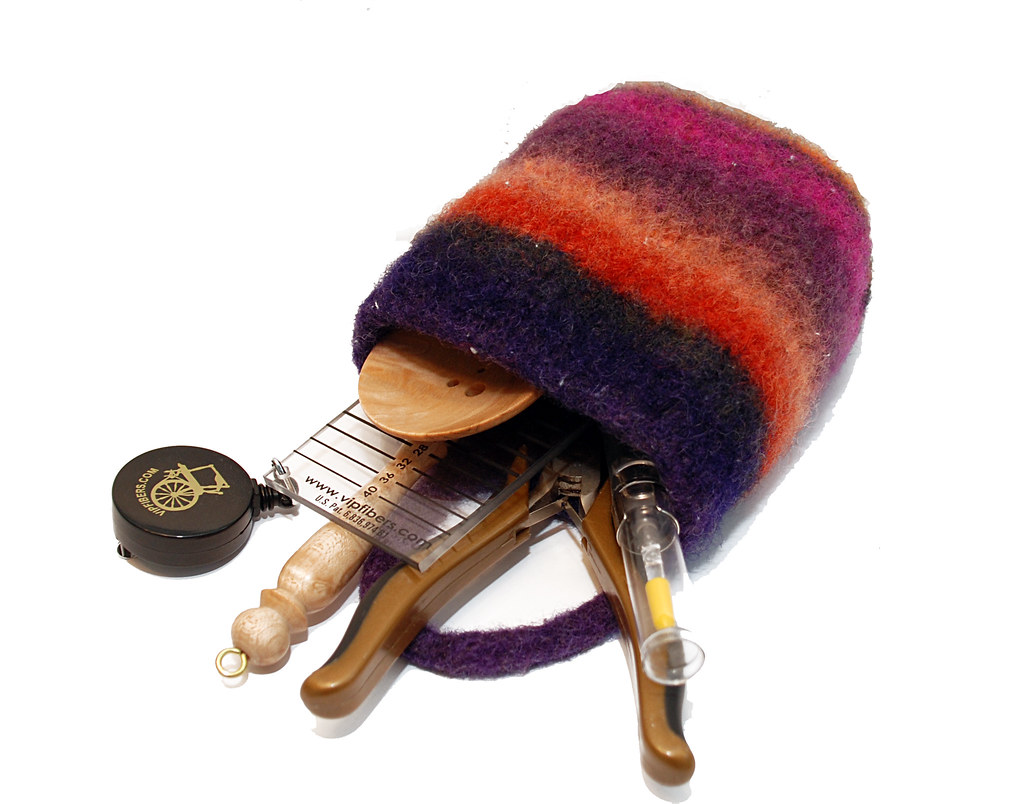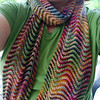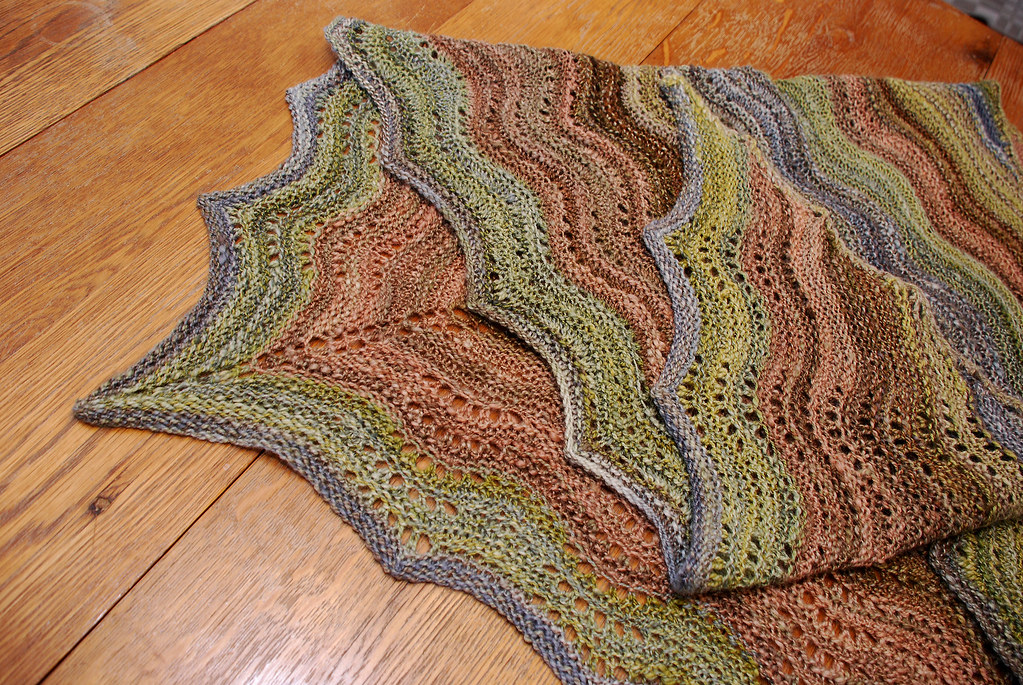 I've finally finished the shawl and I'm pleased with how it came out. the yarn was not spun with this shawl in mind. But as I was spinning the skeins and searching my fiber stash for what to do next, these colors I used it became apparent to me that these colors would work well together. And as I spun each color up, I decided that I wanted to put them all together for a shawl. So, I searched for a pattern and decided on this Feather and Fan Shawl.
I've finally finished the shawl and I'm pleased with how it came out. the yarn was not spun with this shawl in mind. But as I was spinning the skeins and searching my fiber stash for what to do next, these colors I used it became apparent to me that these colors would work well together. And as I spun each color up, I decided that I wanted to put them all together for a shawl. So, I searched for a pattern and decided on this Feather and Fan Shawl. When I started knitting the shawl I wasn't sure I liked how the colors were working up together. I was getting a weird retro vibe that seemed to scream thrift shop, but I kept going and the more I knit the more the thing grew on me. I now like the colors together and the finished shawl.
When I started knitting the shawl I wasn't sure I liked how the colors were working up together. I was getting a weird retro vibe that seemed to scream thrift shop, but I kept going and the more I knit the more the thing grew on me. I now like the colors together and the finished shawl. I was surprised how big the thing ended up being after blocking. I'll have to keep that in mind if I knit any more lace type patterns. There is some satisfaction in knowing that I spun the yarn used in this project. I look forward to knitting another project with handspun. The nice thing is that the knitting hides some of the unique features of the handspun and even things out.
I was surprised how big the thing ended up being after blocking. I'll have to keep that in mind if I knit any more lace type patterns. There is some satisfaction in knowing that I spun the yarn used in this project. I look forward to knitting another project with handspun. The nice thing is that the knitting hides some of the unique features of the handspun and even things out.Project Info
Pattern: The Feather and Fan Comfort Shawl by Sarah Bradberry
Yarn: Handspun by me; 5 different skeins of 100% Bluefaced Leicester
Needles: addi TURBO - US# 7 (4.5 mm)
Finished Width: 83 inches
Finished Height: 34 inches
Notes: no modifications were made to pattern; completed 3 repeat sections
Notes: no modifications were made to pattern; completed 3 repeat sections
 This yarn is spun from Falkland wool roving that bought from the Yarn Wench. This is one of two
This yarn is spun from Falkland wool roving that bought from the Yarn Wench. This is one of two  Falkland wool refers to wool grown in the Falkland Islands. It comes from a variety of different sheep and there can be a range of softness and staple length of the fiber. The fiber that the Yarn Wench has a staple length of 2.75-4.5 inches and a micron count of 26. Micron count refers to the average fiber diameter. The smaller the number the finer the fiber. These numbers are similar to merino and this yarn is
Falkland wool refers to wool grown in the Falkland Islands. It comes from a variety of different sheep and there can be a range of softness and staple length of the fiber. The fiber that the Yarn Wench has a staple length of 2.75-4.5 inches and a micron count of 26. Micron count refers to the average fiber diameter. The smaller the number the finer the fiber. These numbers are similar to merino and this yarn is 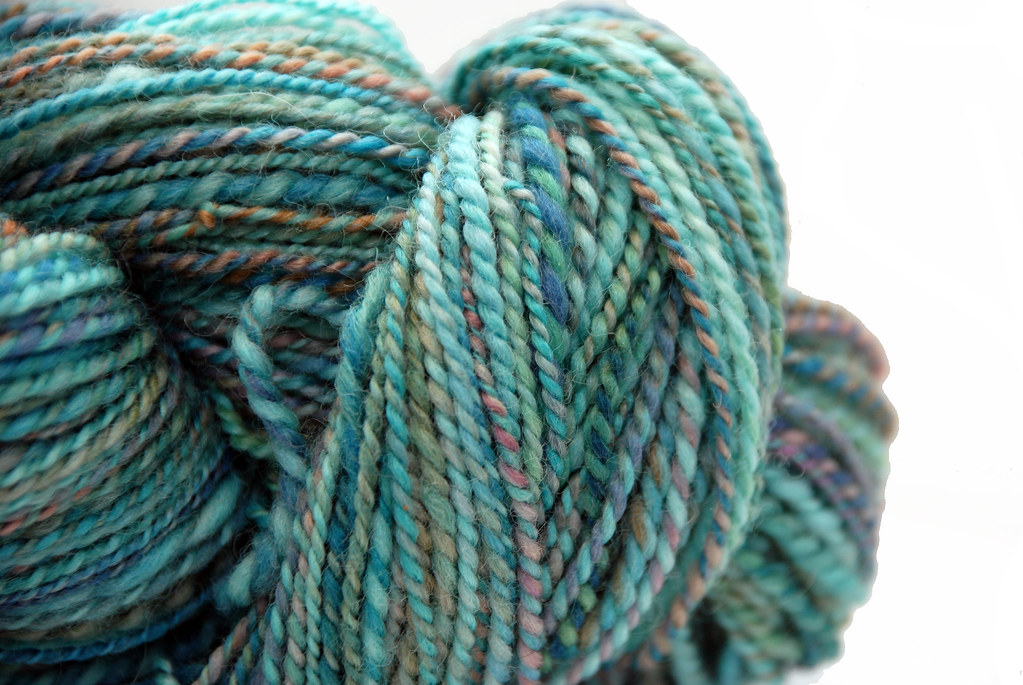 I don't know what I'll knit with this yet. I may combine it with next weeks selection for a nice striped scarf.
I don't know what I'll knit with this yet. I may combine it with next weeks selection for a nice striped scarf.

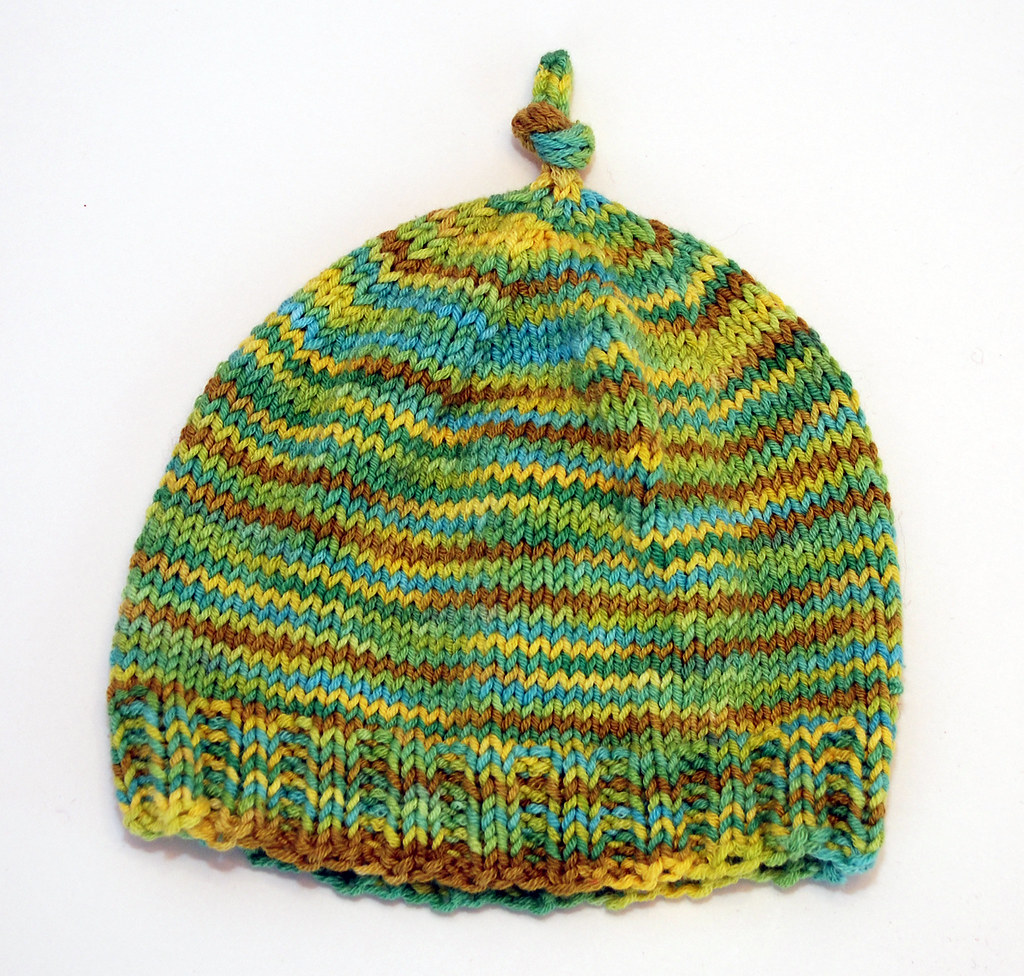 I also decided to pop off a quick baby hat with some leftover sock yarn. This one is knit with Socks That Rock Sock Candy in the kiwi color. Anyway, the hat diversion worked. I'm back to working on my shawls. I'm expecting to have the feather and fan shawl ready for show next week.
I also decided to pop off a quick baby hat with some leftover sock yarn. This one is knit with Socks That Rock Sock Candy in the kiwi color. Anyway, the hat diversion worked. I'm back to working on my shawls. I'm expecting to have the feather and fan shawl ready for show next week.
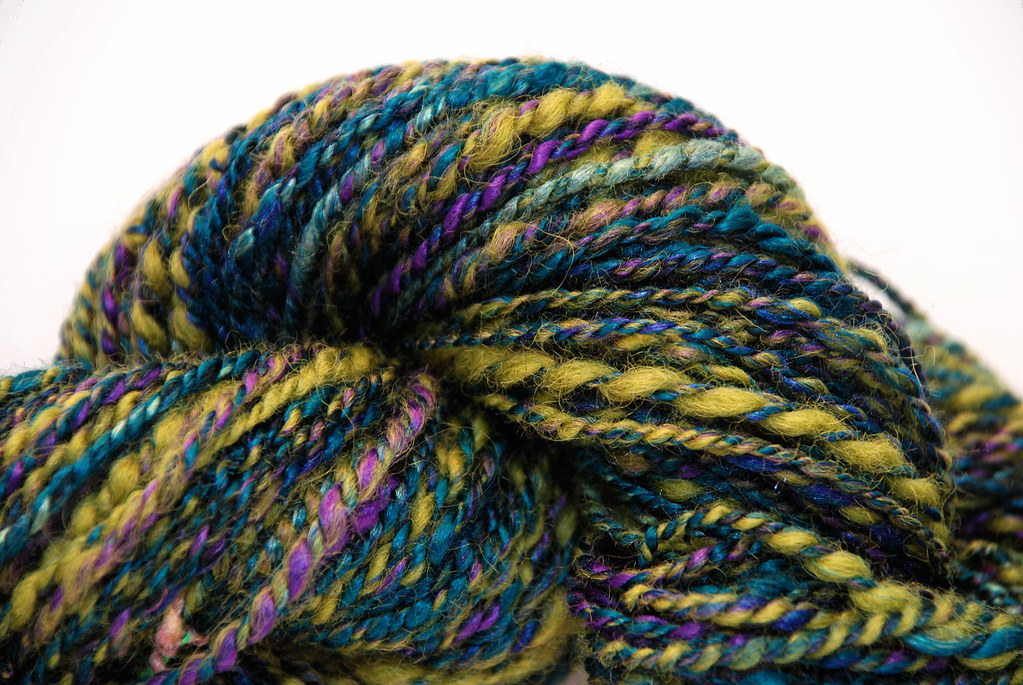 I imagined several different ways of dividing the fiber and spinning it up, but in the end I just split each batt into narrow strips and spun the colors all mixed up onto two bobbins.
I imagined several different ways of dividing the fiber and spinning it up, but in the end I just split each batt into narrow strips and spun the colors all mixed up onto two bobbins. I then just plied the two singles together. I do like the resulting yarn and how the smooth shiny bits are intertwined with the rougher wool.
I then just plied the two singles together. I do like the resulting yarn and how the smooth shiny bits are intertwined with the rougher wool.

 I was also able to get a small baby hat out of the leftovers. I'll put this one in the
I was also able to get a small baby hat out of the leftovers. I'll put this one in the 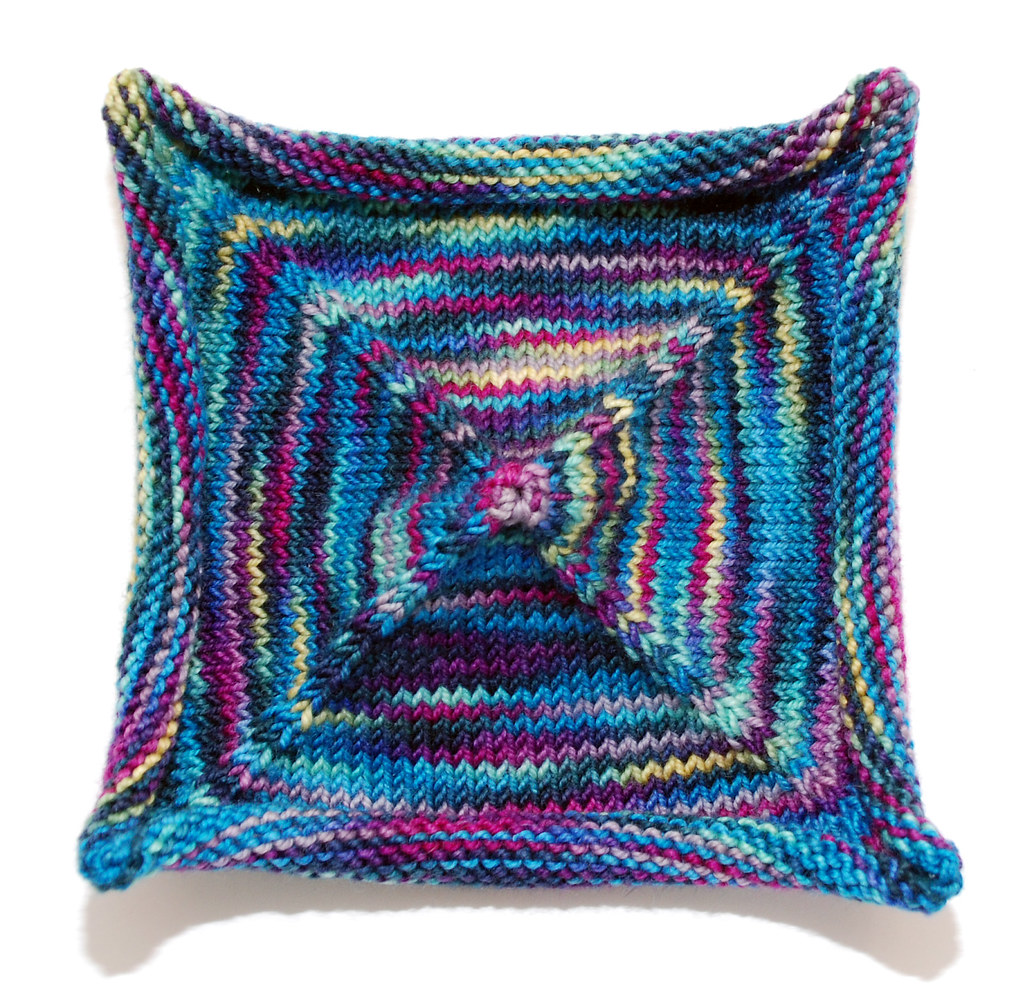

 I really liked working with this fiber. The dye job was great and the fiber was easy to draft and work with. I have one more braid of Bluefaced Leicester from this dyer, Pigeonroof Studios. I have a hard time getting any fiber from this dyer though, because it seems like as soon as she posts any new fiber to esty it is gone in a flash. I was lucky to get two braids of merino last night though.
I really liked working with this fiber. The dye job was great and the fiber was easy to draft and work with. I have one more braid of Bluefaced Leicester from this dyer, Pigeonroof Studios. I have a hard time getting any fiber from this dyer though, because it seems like as soon as she posts any new fiber to esty it is gone in a flash. I was lucky to get two braids of merino last night though. This is the first skein for which I tried to take a wpi (wraps per inch) measurement. I do think that if I had taken this measurement in a couple different places in the skein I would have gotten some variety in the results. But I'm going to try and start collecting this information anyway. I got a wpi of 19 for this skein, but I'm not too sure if that is accurate.
This is the first skein for which I tried to take a wpi (wraps per inch) measurement. I do think that if I had taken this measurement in a couple different places in the skein I would have gotten some variety in the results. But I'm going to try and start collecting this information anyway. I got a wpi of 19 for this skein, but I'm not too sure if that is accurate.
 I finally started a project with my handspun yarn. I didn't have this project planned when I bought the fiber, but as I spun each color up I realized that I could put them together and end up with something a little bigger than hat or a scarf.
I finally started a project with my handspun yarn. I didn't have this project planned when I bought the fiber, but as I spun each color up I realized that I could put them together and end up with something a little bigger than hat or a scarf.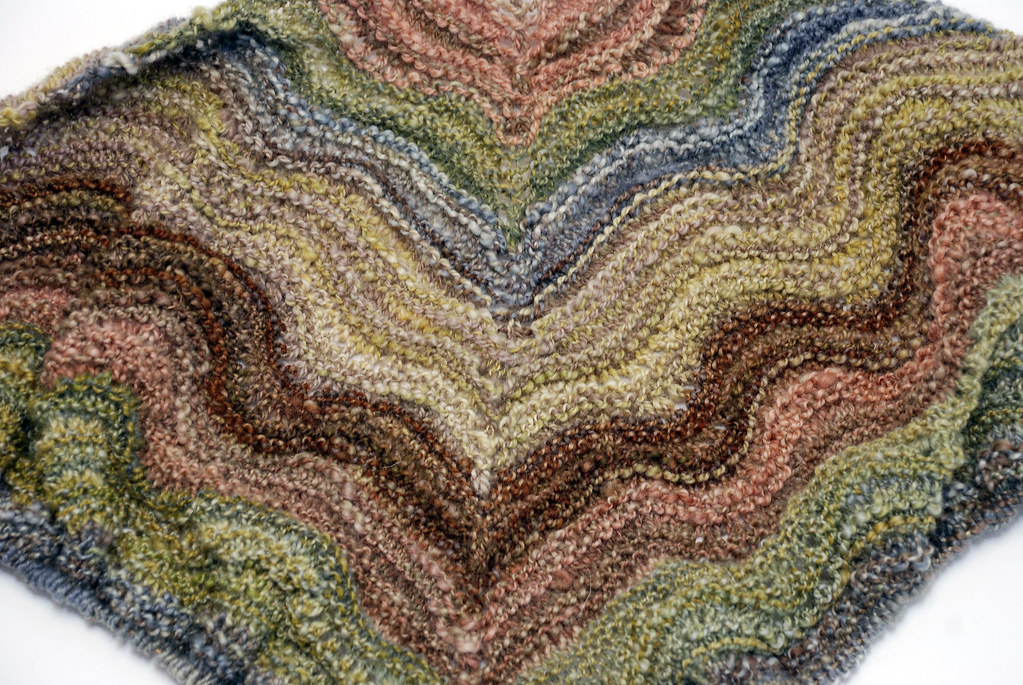 I settled on the
I settled on the  So I decided to start a pair of socks. I went through my stash and settled on a skein of Socks That Rock in medium weight. I went looking for a pattern and decided to try out
So I decided to start a pair of socks. I went through my stash and settled on a skein of Socks That Rock in medium weight. I went looking for a pattern and decided to try out  While I was selecting a skein of sock yarn, I ran across some Silk Garden I had put aside for the Lady Eleanor Stole from Scarf Style. So, I decided to start that too. This was one of the first projects I picked out when I learned to knit. I've always passed it by to start some other project though. I just assumed that entrelac would be difficult. Sunday was the first time I actually sat down and read through the pattern. I love the effect and it is surprisingly easy. Now I've just got to finish something!
While I was selecting a skein of sock yarn, I ran across some Silk Garden I had put aside for the Lady Eleanor Stole from Scarf Style. So, I decided to start that too. This was one of the first projects I picked out when I learned to knit. I've always passed it by to start some other project though. I just assumed that entrelac would be difficult. Sunday was the first time I actually sat down and read through the pattern. I love the effect and it is surprisingly easy. Now I've just got to finish something!

 There are several extra parts that came with the wheel that aren't pictured here. I have a couple different flyers and extra bobbins. The flyers are part of what determine the rate at which twist is put into the fiber and holds the bobbin. You can see the arms of the flyer and the bobbin in the above picture. You can also see that beautifully dyed fiber I've been working on from the Yarn Wench. It will show up as a finished yarn on some future Friday.
There are several extra parts that came with the wheel that aren't pictured here. I have a couple different flyers and extra bobbins. The flyers are part of what determine the rate at which twist is put into the fiber and holds the bobbin. You can see the arms of the flyer and the bobbin in the above picture. You can also see that beautifully dyed fiber I've been working on from the Yarn Wench. It will show up as a finished yarn on some future Friday.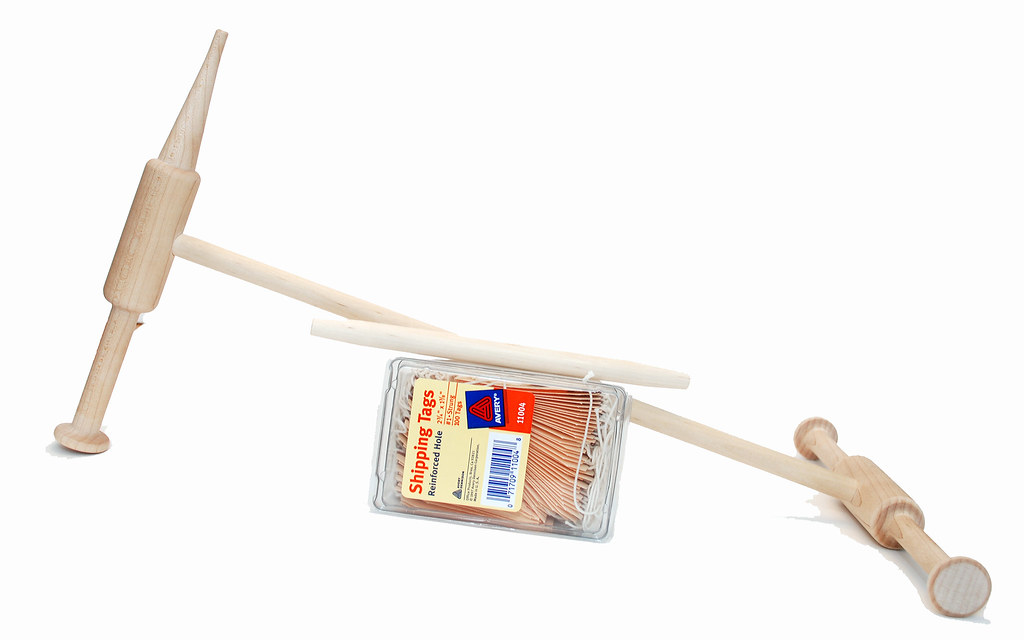 I also needed a way to get the yarn off of the wheel and into a hank. I use a kniddy knoddy for that. I can also estimate the yardage by counting the number of times the yarn is wrapped around it. I ended up with a kniddy knoddy that can make a 2 yard skein or a small 1 yarn skein. The end pieces come off and attached to 2 different lengths of wood. I use this tool a lot, but I wouldn't buy this particular one again. The end pieces don't stay on well and that makes it very difficult to use. I need to glue the end pieces on, but that will mean it is no longer adjustable. The shipping labels are what i use to tag each skein of yarn when it is finished. I put fiber content, weight, yardage and anything else I can think of that I might want to remember.
I also needed a way to get the yarn off of the wheel and into a hank. I use a kniddy knoddy for that. I can also estimate the yardage by counting the number of times the yarn is wrapped around it. I ended up with a kniddy knoddy that can make a 2 yard skein or a small 1 yarn skein. The end pieces come off and attached to 2 different lengths of wood. I use this tool a lot, but I wouldn't buy this particular one again. The end pieces don't stay on well and that makes it very difficult to use. I need to glue the end pieces on, but that will mean it is no longer adjustable. The shipping labels are what i use to tag each skein of yarn when it is finished. I put fiber content, weight, yardage and anything else I can think of that I might want to remember. Of course there are kinds of little gadgets too. I usually spin in bare feet or some type of slipper sock because they have little rubberized things on the bottom. I have found that my feet slide around too much in regular socks. I have found a knitting pattern for similar socks and plan to replace the store bought ones here with some knit from my own handspun. I've got two WPI tools (wraps per inch). I bought the one laying on the pink socks from etsy. The other came as part of my spinning lesson a couple of weeks ago. I haven't used them too much yet, but I'm going to start noting that for all my handspun yarns. The little bottle with the yellow tip is oil. I think I've only used one drop to date. The plastic card with the black lines is meant to help you check the thickness of your yarn as you spin. It was in my stocking for Christmas, but I haven't used this it at all yet. The project cards on the left are a great idea and were also part of my recent lesson. you can record all types of pertinent info about a specific spinning project as well as a sample of the singles yarn and the plied yarn. This will be extremely helpful when I'm spinning enough yarn for a larger project and want to be able to make consistent yarn for the whole project.
Of course there are kinds of little gadgets too. I usually spin in bare feet or some type of slipper sock because they have little rubberized things on the bottom. I have found that my feet slide around too much in regular socks. I have found a knitting pattern for similar socks and plan to replace the store bought ones here with some knit from my own handspun. I've got two WPI tools (wraps per inch). I bought the one laying on the pink socks from etsy. The other came as part of my spinning lesson a couple of weeks ago. I haven't used them too much yet, but I'm going to start noting that for all my handspun yarns. The little bottle with the yellow tip is oil. I think I've only used one drop to date. The plastic card with the black lines is meant to help you check the thickness of your yarn as you spin. It was in my stocking for Christmas, but I haven't used this it at all yet. The project cards on the left are a great idea and were also part of my recent lesson. you can record all types of pertinent info about a specific spinning project as well as a sample of the singles yarn and the plied yarn. This will be extremely helpful when I'm spinning enough yarn for a larger project and want to be able to make consistent yarn for the whole project.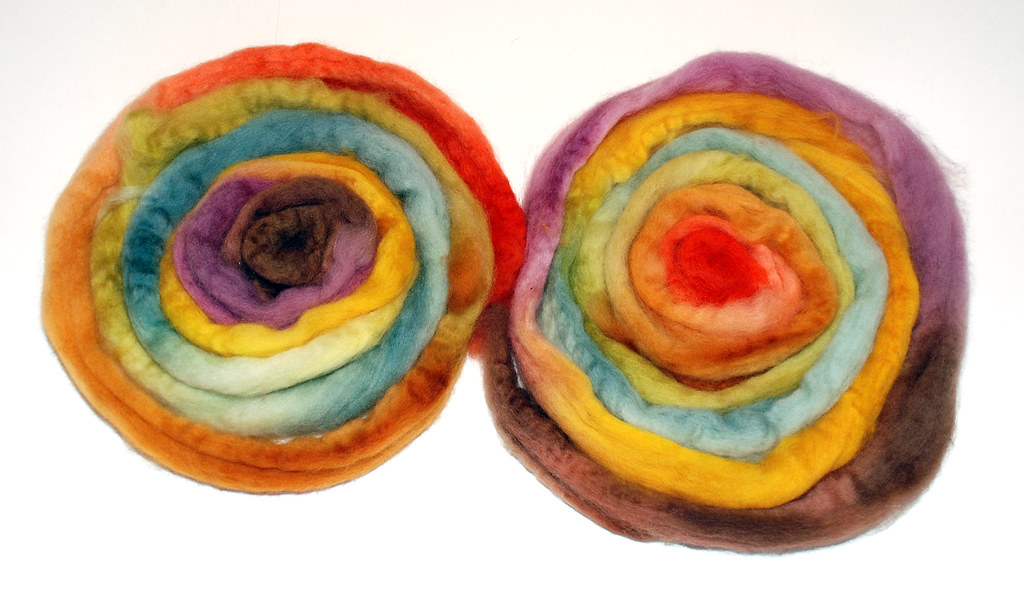 I took a look through my fiber stash this weekend to decide what to work on next. I pulled out this Bluefaced Leicester that I bought at SAFF last year. I pulled the fiber into two pieces lengthwise and coiled them up from opposite ends. I think I'm going to try and spin up a self striping yarn 2 ply yarn.
I took a look through my fiber stash this weekend to decide what to work on next. I pulled out this Bluefaced Leicester that I bought at SAFF last year. I pulled the fiber into two pieces lengthwise and coiled them up from opposite ends. I think I'm going to try and spin up a self striping yarn 2 ply yarn.

 I'm going to cast on for this project over the weekend. I'm really looking forward to knitting with some of my handspun. I knit a hat using some of my handspun before, but this actually seems a little more substantial and a better test.
I'm going to cast on for this project over the weekend. I'm really looking forward to knitting with some of my handspun. I knit a hat using some of my handspun before, but this actually seems a little more substantial and a better test. I'm also going to do some spinning. I need to pull out all my stashed fiber and see what I can come up with. I'd like to go ahead and spin for another project but I also like just sitting down to spin up a random skein. It might also be nice to go ahead and take photos of all the fiber now so I can have before and after shots for spinning projects. Would it be interesting if I posted a picture of the fiber and finished yarn?
I'm also going to do some spinning. I need to pull out all my stashed fiber and see what I can come up with. I'd like to go ahead and spin for another project but I also like just sitting down to spin up a random skein. It might also be nice to go ahead and take photos of all the fiber now so I can have before and after shots for spinning projects. Would it be interesting if I posted a picture of the fiber and finished yarn?
 The fiber was anything but a pleasure to spin. It was all full of little neps. Neps are little tangles or snarls of short fibers and usually occur during the carding process. Carding is a preparation that makes all those lovely fiber batts. But the individual fibers aren't as parallel as say with combing and shorter fibers can have a tendency to snarl and form these little tangles. I though about trying to pull these out as I was spinning, but there were really too many of them to even start to try that. It also made the fiber a little harder to draft into a smooth fine yarn.
The fiber was anything but a pleasure to spin. It was all full of little neps. Neps are little tangles or snarls of short fibers and usually occur during the carding process. Carding is a preparation that makes all those lovely fiber batts. But the individual fibers aren't as parallel as say with combing and shorter fibers can have a tendency to snarl and form these little tangles. I though about trying to pull these out as I was spinning, but there were really too many of them to even start to try that. It also made the fiber a little harder to draft into a smooth fine yarn. I probably should have realized all of this before I started spinning and worked out a way to make it work, but I didn't. I get very excited when I'm going to sit down to spin and usually just jump right in. I think I could have spun a thicker or loftier yarn and hid even more of these little things. I do think that knitting will actually hide some of them too. Ah well, spin and learn right?
I probably should have realized all of this before I started spinning and worked out a way to make it work, but I didn't. I get very excited when I'm going to sit down to spin and usually just jump right in. I think I could have spun a thicker or loftier yarn and hid even more of these little things. I do think that knitting will actually hide some of them too. Ah well, spin and learn right?

